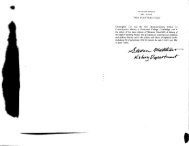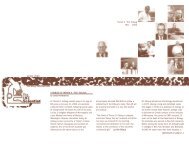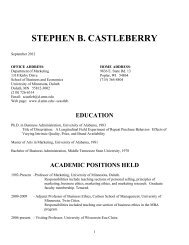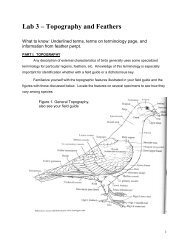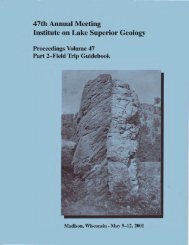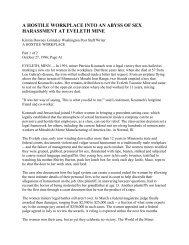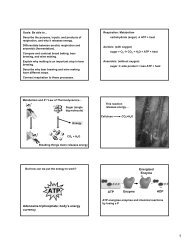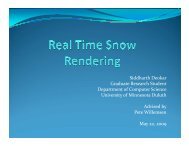Petrology and Cu-Ni-PGE Mineralization of the Bovine Igneous ...
Petrology and Cu-Ni-PGE Mineralization of the Bovine Igneous ...
Petrology and Cu-Ni-PGE Mineralization of the Bovine Igneous ...
You also want an ePaper? Increase the reach of your titles
YUMPU automatically turns print PDFs into web optimized ePapers that Google loves.
Abstract<br />
The <strong>Bovine</strong> <strong>Igneous</strong> Complex (BIC), located 8 kilometers sou<strong>the</strong>ast <strong>of</strong> <strong>the</strong> town<br />
<strong>of</strong> L’anse, Michigan, is a small basin-shaped mafic/ultramafic intrusion emplaced in <strong>the</strong><br />
southwestern part <strong>of</strong> <strong>the</strong> Paleoproterozoic Baraga Basin. Although age dating <strong>of</strong> <strong>the</strong> BIC<br />
intrusion has so far been unsuccessful, <strong>the</strong> intrusion was very likely emplaced during <strong>the</strong><br />
early magmatic stage <strong>of</strong> Midcontinent Rift development, given its similarities to o<strong>the</strong>r<br />
mineralized early stage intrusions, such as Tamarack <strong>and</strong> Eagle. Targeted by Kennecott<br />
as a <strong>Cu</strong>-<strong>Ni</strong>-<strong>PGE</strong> prospect, <strong>the</strong> intrusion has undergone extensive exploration drilling<br />
since 1995. To date, <strong>the</strong> intrusion has been found to be only weakly to moderately<br />
mineralized with <strong>Cu</strong>-<strong>Ni</strong>-<strong>PGE</strong> sulfides. Metal tenors provided by initial drilling averaged<br />
less than .5% <strong>Cu</strong> <strong>and</strong> <strong>Ni</strong>, <strong>and</strong> less than 350 ppb Pt <strong>and</strong> Pd (Rossell, 2008). Preliminary<br />
evaluation <strong>of</strong> field mapping, core logging <strong>and</strong> geochemical data by Rossell (2008)<br />
interpreted <strong>the</strong> intrusion to be a layered ultramafic/mafic body with an igneous<br />
stratigraphy composed <strong>of</strong> a basal wehrlite, overlain by a clinopyroxenite, <strong>and</strong> capped by a<br />
gabbro.<br />
This study was undertaken to fur<strong>the</strong>r refine <strong>the</strong> igneous stratigraphy <strong>of</strong> <strong>the</strong> BIC,<br />
specifically its phase layering <strong>and</strong> cryptic variation, toward <strong>the</strong> goal <strong>of</strong> better<br />
underst<strong>and</strong>ing its emplacement, crystallization, <strong>and</strong> mineralization history. For this<br />
study, two drill cores (BIC01-01 <strong>and</strong> 08BIC-044) that pr<strong>of</strong>ile <strong>the</strong> BIC were investigated<br />
for <strong>the</strong>ir petrographic attributes, cryptic mineral compositions, <strong>and</strong> whole rock<br />
lithochemistry. In addition, a detailed (1:6,000) re-mapping <strong>of</strong> <strong>the</strong> BIC was conducted.<br />
This study has found that <strong>the</strong> lithostratigraphy <strong>of</strong> <strong>the</strong> main intrusion is generally<br />
similar to that found by Rossell (2008), but when mineral modes <strong>and</strong> textures are factored<br />
in, <strong>the</strong> cumulate stratigraphy <strong>of</strong> <strong>the</strong> BIC is found to progresses from an olivine cumulate<br />
with intercumulus augite <strong>and</strong> plagioclase (feldspathic wehrlite unit), to an augite+olivine<br />
cumulate with intercumulus plagioclase (feldspathic olivine clinopyroxenite unit), to an<br />
augite+oxide±olivine cumulate with intercumulus plagioclase (oxide clinopyroxenite<br />
unit), <strong>and</strong> finally, a plagioclase+augite+oxide cumulate (oxide gabbro unit) at <strong>the</strong> top.<br />
Complimenting this cumulate phase layering is a smooth cryptic variation <strong>of</strong> upward<br />
decreasing mg# in olivine <strong>and</strong> augite composition.<br />
ii




